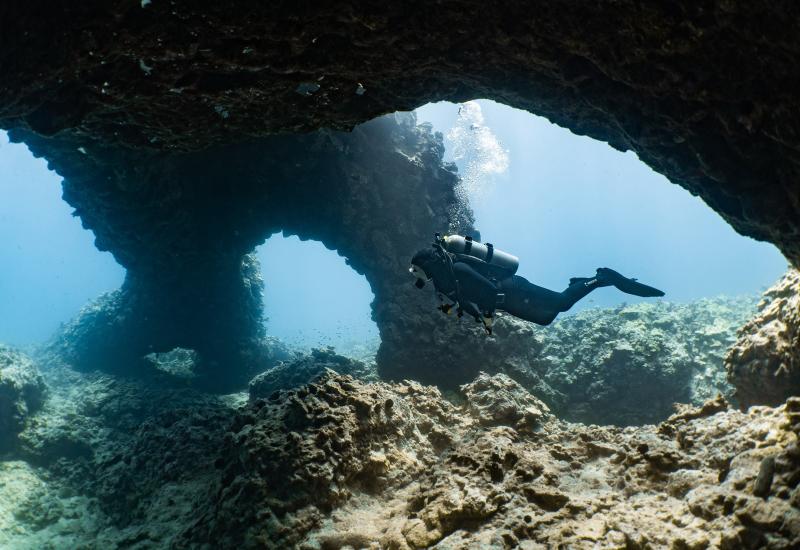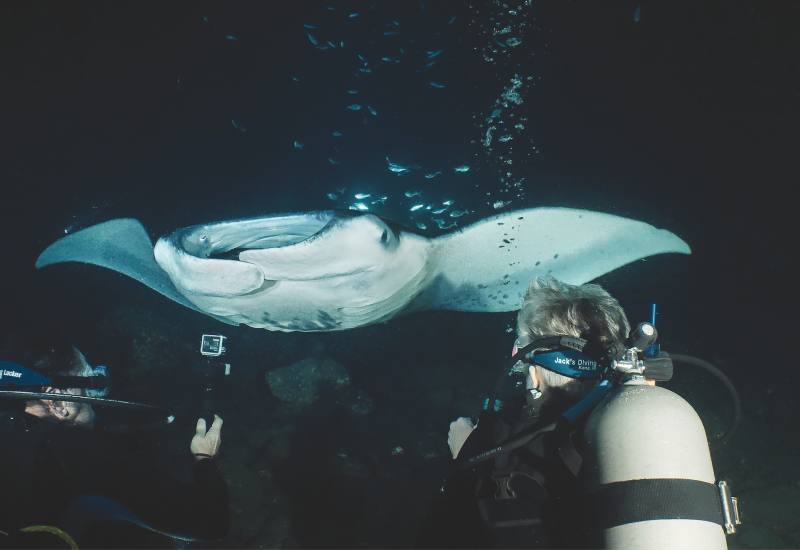First Hawaiian Blackwater Diving Guide to be Released in October

Jeffrey MilisenA rhomboid squid.
On Jeffrey Milisen’s first blackwater dive, he watched a rare cookiecutter shark fly directly at his friend's back.
“I looked up at his mom, like, how are we going to get this guy's attention? He's about to have a hole in his back,” said Milisen. “And she was buried behind her camera watching the shark charge at her son. It was really, really awesome.”
The ocean’s dark aliens immediately kidnapped him that night in 2009, and haven’t let him go since. He is now ready to share their stories in his new book, A Field Guide to Blackwater Diving in Hawai’i, coming October 15th.
Featuring more than 250 animals, Milisen's field guide provides a research overview and observations on everything from miniscule baby squids to forty-foot jellyfish. The first half of the book details jellies, ctenophores, crustaceans, worms and mollusks, including cephalopods. The second half is devoted to adult and larval fishes. Photographs taken by Milisen over the last 11 years off the shores of Kona accompany the entries, including some from that first dive with the cookiecutter shark.

Jeffrey MilisenA carangid swims inside a jellyfish.
Most of the animals included are found several miles off of Kona in less than 50 feet of water. A world-famous night diving destination, the black waters teem with creatures normally dispersed throughout the water column, many too deep for recreational divers to see during the day.

Jeffrey MilisenBrotulataenia
“I think a lot of people have heard the term vertical migration,” he said. “When I think of it, I think of it as squishing a lot of the ocean up near the surface, because you've got a lot of slices of the ocean that all kind of come together in that mixing bowl.”
The book’s release will be the culmination of a passion project that began during Milisen’s childhood. A self-described “lifelong critter nerd,” field guides have always been the “centerpiece” of his library. Ocean animals entered the picture in 2001 when he got scuba certified to tend the tanks at a local aquarium during his “first attempt at undergrad” at Eastern Connecticut State University.
Nearly a decade later, Milisen moved to Hawaii to finish that undergraduate degree, eventually earning his masters in Molecular Biosciences and Bioengineering from the University of Hawai‘i-Manoa. There he started a research project documenting the habitats and diversity of the ocean’s night creatures, with a “pie-in-the-sky” idea of someday turning his observations into one of those revered field guides.
Now that he has, he hopes it helps demystify the deep.

Jeffrey MilisenThe planktonic larva of a sea snail floats through the Pacific.
“When you see a little glob of snot in the water, you have no idea where to start identifying this thing,” he said. “You have no idea what phyla it is in, what order, what it is related to,” so “one of my big goals ...was to make plankton and nekton and midwater and epipelagic animals palatable — put them in a format that people can understand.”
Milisen also views his field guide as a call to better understand the ocean, not just name it. Most divers spend their bottom time exploring reefs and shore dives in the shallow waters that comprise only eight percent of the ocean.
“And the rest is this pelagic ocean,” he said. “And people have no concept of that beyond the menu at their sushi restaurant. If it's not a tuna, or a whale, or a shark, or some kind of charismatic megafauna, they had no clue. So this book is to help start to bridge that gap.”
A Field Guide to Blackwater Diving in Hawai’i is available for preorder through Mutual Publishing. After its release, it will be available for purchase online, as well as at book stores and dive shops around Hawaii. Milisen plans to hold “dive with the author” events at Kona Honu Divers, where he is a guide. Exact details are to be announced at a later date.
Related










